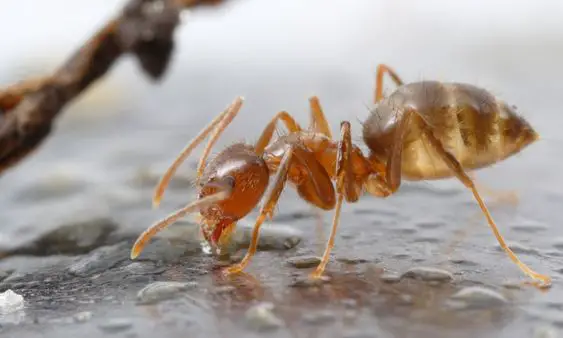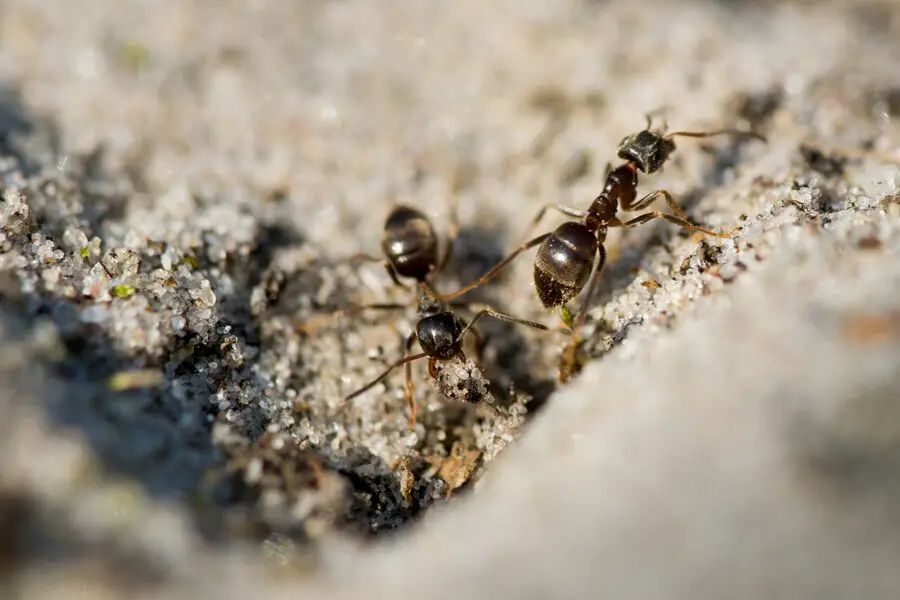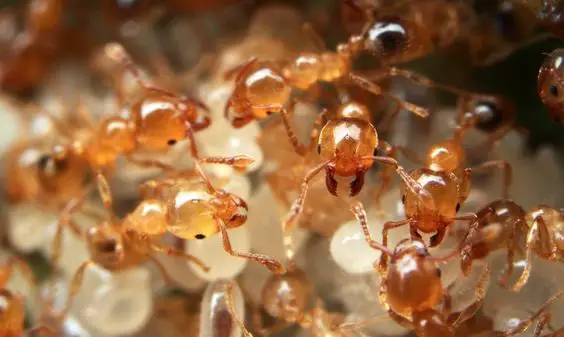Ants are one of the most common insects in the world, and Louisiana is no exception. With its humid climate and diverse ecosystems, Louisiana provides a perfect home for a variety of ant species.
While some ants are simply a nuisance, others can cause significant damage to property and crops.
In this article, we will take a closer look at the most common ants in Louisiana, including their identification, behavior, and impact on the environment.
Types of Ants in Louisiana
In Louisiana’s warm and humid environment, ants thrive and come in all shapes and sizes. From the tiny odorous house ant to the big carpenter ant, these little critters are everywhere! While some ants can be a bit of a nuisance, others are actually pretty helpful, keeping our gardens clean and controlling insect populations.
Red Imported Fire Ants in Louisiana

Red imported fire ants (RIFA) are an invasive species of ant that has been wreaking havoc on Louisiana’s ecosystem and economy for decades.
- Size & color: Red imported fire ants are an invasive species of ant that is found in all 64 parishes of Louisiana. They are reddish-brown in color and range in size from 1/8 to 1/3 of an inch in length. Queens can be up to 1/2 an inch long.
- Habitat: They are commonly found in lawns, gardens, pastures, and fields. They may also be found in urban areas, including parks, playgrounds, and sidewalks.
- Biodiversity: RIFA are a major threat to biodiversity in Louisiana. They prey on native insects and other wildlife, and they can also displace native ant species.
- Complications: Their stings are painful and can cause allergic reactions in some people. They can also damage crops and livestock. In Louisiana, RIFA are estimated to cause over $100 million in damage to agriculture each year.
- Impact: RIFA have a significant impact on the environment, economy, and public health of Louisiana. They are a major nuisance pest, and they pose a serious threat to native biodiversity. The state of Louisiana spends millions of dollars each year on RIFA control efforts.
Crazy Ant in Louisiana

Louisiana’s Crazy Ants (officially known as Tawny Crazy Ants), scientifically named Nylanderia fulva, are an invasive species of ant that has spread rapidly across the state.
- Size & Color: These ants are characterized by their reddish-brown coloration and range in size from 1/16 to 1/8 of an inch in length.
- Habitat: Crazy Ants are highly adaptable and can thrive in a variety of habitats, including urban and rural areas. They are commonly found in lawns, gardens, homes, and electrical equipment.
- Biodiversity: Crazy Ants pose a significant threat to Louisiana’s biodiversity. They are voracious predators and can decimate populations of native insects, including bees, spiders, and lizards.
- Complications: Crazy Ants are not known to sting, but they can bite, causing a sharp, painful sensation. They are also known to contaminate food and surfaces with bacteria and other pathogens.
- Impact: Crazy Ants are considered a major nuisance pest in Louisiana. They can invade homes and businesses, causing damage to electrical equipment and food contamination.
Argentine Ant in Louisiana

The Argentine ant is a small ant that is found all over the world, including Louisiana. These ants are not known to bite, but they can be a nuisance in homes and businesses.
- Size & color: Argentine ants are small, light brown to dark brown ants. Workers are about 1/16 to 1/8 inch long, and queens are about 1/4 inch long.
- Habitat: Argentine ants are native to Argentina and Brazil, but they have been introduced to many parts of the world, including Louisiana. They are most commonly found in urban and suburban areas, but they can also be found in rural areas.
- Biodiversity: Argentine ants can have a negative impact on biodiversity. They are a competitive species that can displace native ants and other insects.
- Complications: Argentine ants can be a nuisance to humans. They can invade homes and businesses, and they can contaminate food and surfaces. They can also sting, although their stings are not usually painful.
- Impact: Argentine ants are a major agricultural pest. They can damage crops and livestock. They are also estimated to cause millions of dollars in damage to property each year in the United States.
Carpenter Ant in Louisiana

Carpenter ants are native to North America and Europe. They are found in many parts of the United States, including Louisiana.
- Size & Color: Carpenter ants are one of the largest ant species in North America. Workers range from 1/4 to 1/2 inch in length, and queens can be up to ¾ inch long. They are typically black, reddish-brown, or a combination of both colors.
- Habitat: Carpenter ants are found in all 64 parishes of Louisiana. They prefer to nest in moist, decaying wood, such as in older homes, trees, and other wooden structures.
- Biodiversity: Carpenter ants do not eat wood, but they excavate tunnels and galleries in wood to create their nests. This can damage the structural integrity of wooden structures, such as homes, bridges, and utility poles.
- Complications: Carpenter ants can be a nuisance to homeowners and businesses. They can invade homes and businesses, and they can damage wood structures. They can also contaminate food and surfaces.
- Impact: Carpenter ants are estimated to cause millions of dollars in damage to property each year in Louisiana. They can also damage crops and livestock.
Odorous House Ant

Odorous house ants, scientifically known as Tapinoma sessile, are a common and widespread pest species in Louisiana.
- Size & Color: Odorous house ants are small, dark brown to black ants. Workers range from 1/16 to 1/8 inch in length, and queens are about 1/4 inch long. They are named for the strong, unpleasant odor they emit when they are crushed.
- Habitat: Odorous house ants are found in all 64 parishes of Louisiana. They prefer to nest outdoors in moist, shady areas, such as under rocks, mulch, and in the ground. They can also be found in homes and businesses, where they are attracted to food and moisture.
- Biodiversity: Odorous house ants can be a nuisance to native insects. They can also compete with native ants for food and resources.
- Complications: Odorous house ants are not known to sting, but they can bite. Their bites are not usually painful, but they can cause itching and redness. They can also contaminate food and surfaces.
- Impact: Odorous house ants are a major pest in Louisiana. They can invade homes and businesses, and they can contaminate food and surfaces. They can also make outdoor activities unpleasant.
Conclusion about Ants in Louisiana
Ants are everywhere in Louisiana, and they’re a big part of the state’s ecosystem. Some ants, like fire ants, can be a pain in the neck (and sometimes even dangerous), but others play a valuable role in the environment.
The next time you see a line of ants marching through your yard or a few wandering around your house, take a moment to appreciate them.
They’re more than just tiny pests; they’re tiny architects, gardeners, and sometimes even formidable adversaries.
So next time you see an ant, give them a little respect. They’re more than just tiny pests; they’re tiny members of our ecosystem.



